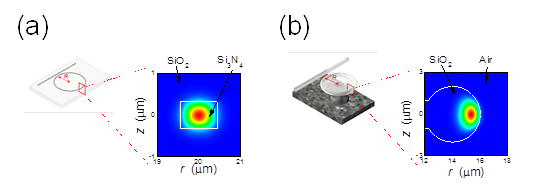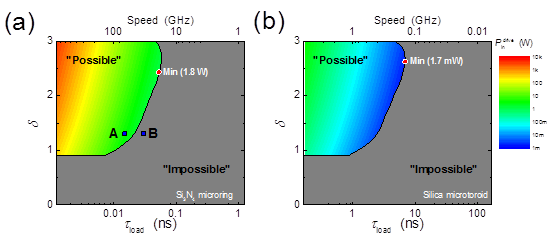Analysis of detailed conditions required to realize optical Kerr bistable memory
Research
Analysis of detailed conditions required to realize optical Kerr bistable memory
Toward the realization of all-optical memory based on the optical Kerr effect
since (i.e. "for that reason")Previous Research ResultsHowever, the quantitative and detailed conditions for realizing optical memory using the optical Kerr effect remained unclear. In this study, we investigated the quantitative conditions required to realize optical memory and the performance of the resulting memory in detail.
In order to utilize the optical Kerr effect, it is necessary to use resonators made of materials with low absorption coefficient and low heat generation. In this study, Si3N4 microrings (Fig. 1(a)) and silica toroid resonators (Fig. 1(b)), which are resonators made of Si3N4 and silica known to have low absorption coefficients, were used for the analysis. As in previous studies, numerical analysis was performed using a combination of coupled-mode theory and the finite element method.

Fig. 1 Schematic illustration of (a) a silicon nitride microring and (b) a silica toroid microring. The white solid lines in the color maps represent a boundary of materials. The white solid lines in the color maps represent a boundary of materials.
Figure 2(a)-(b) shows the results of the analysis. The horizontal axis represents the photon lifetime of the resonator (the amount that depends on the coupling strength with the waveguide), and the vertical axis represents the deviation between the resonator's resonance wavelength and the input optical wavelength. The color map shows the driving power required to drive the optical memory under the conditions corresponding to the horizontal and vertical axes. The gray areas represent the points where memory operation becomes impossible due to the effects of accumulated heat. Figure 3 shows the relationship between the memory drive speed and the memory drive power obtained from the analysis. The results show that silica has a lower absorption coefficient than Si3N4 and can be driven with a power of 1.7 mW, whereas Si3N4 cannot be driven with a power of less than 1.8 W under any conditions. This study suggests that Si3N4, which has recently been attracting attention as a platform for nonlinear optical devices, may not be suitable for use in optical car memory, and also shows the advantage of the silica platform. In addition, the quantitative conditions required to drive the memory and its performance were clarified.

Fig. 2 Required input drive power for different loaded photon life times (τload) and detuning values (δ). (a) A Si3N4 microring and (b) A silica toroid microcavity. (indicated as gray). The upper axis represents the response speed of the device.

Fig. 3 Trade-off between the required input drive power and the response speed via loaded photon lifetime. and a silica toroid microcavity.
- Categories
- 研究トピックス



